Sales documents are an essential part of any successful sales strategy. Understanding their importance can make a world of difference in your sales success. When it comes to sales, having the right documents that match with your company policies is highly crucial to business. Such documents are the tools that sales professionals use to communicate value, build credibility, and ultimately close deals.
But with so many different types of sales documents available, it can be difficult to know which ones to use, how to create them effectively, and how to use them to maximize your sales potential.
In this blog, we’ll dive into the world of sales documents, exploring their importance in the sales process and discussing various types of sales documents that are critical for success. From proposals and contracts to sales scripts and call scripts, we’ll cover it all.
We will give you useful sales document insights. Additionally, we will also offer free templates for different types of sales documents, so you can boost productivity and simplify your sales process.
So, if you’re ready to take your sales game to the next level, keep reading

Table of Contents
- What is a Sales Document?
- Benefits of Sales Documentation in the Sales Process
- Types and Examples of Sales Documents
- 1. Sales Proposals & Quotations
- 2. Business Trackers
- 3. WhatsApp Sales Messages
- 4. Sales Follow-Up Emails
- 5. SOP (Standard Operating Procedure)
- 6. KPI
- 7. KRA
- 8. Credit & Collection
- 9. Sales Emails
- 10. Telemarketing Scripts
- 11. Sales Plan
- 12. Case Studies
- 13. Sales Decks
- 14. Invoices
- 15. Playbooks
- 16. Pricing Sheets
- How to create Sales Documentation?
- Sales Documents FAQ’s
- Sales Documents Tips and Tricks
What are Sales Documents?
A sales document is any type of document used in the sales process, from prospecting to closing deals. They can take many forms, including contracts, proposals, invoices, and more. Moreover they help the salesperson and the possible customer talk to each other in a clear way. With this you can make sure that both sides understand the terms of the sale and that everyone is on the same page.
These documents can come in many different forms. The specific type of sales document that a salesperson uses will depend on three things- stage of the sales process, the needs and preferences of the prospect, and the goals of the sales team. They help to communicate the value of their offerings, persuade potential customers to make a purchase, and close deals.
Benefits of Sales Documentation in the Sales Process
Sales Documents Clarify Sales Processes: Sales documents clarify the sales process by outlining the terms of the agreement, the buyer’s obligations, and the seller’s liabilities. This prevents miscommunication.
Sales Documents Increases Credibility: Good sales materials increase credibility with prospective clients, demonstrating the salesperson’s competence, organization, and seriousness.
Demonstrate Value with Sales Documents: Sales documents also provide the chance to demonstrate the value of the product or service by describing its benefits, helping prospective buyers understand why they should choose it over others.
Improve Communication via Sales Documents: Clear and succinct sales documents enhance communication between salespeople and customers. It will allow potential clients to understand the offering and communicate concerns effectively.
Sales Documents Help Close Deals: Sales documents are vital in closing sales. They provide the customer with the required knowledge to make an informed purchase, and they can help overcome any objections or concerns.
Sales Documents Foster Collaboration: Moreover, sales documentation can facilitate collaboration across sales teams and other organizations. Having a consistent set of sales documents enables teams to collaborate more effectively and efficiently.
Sales Documents Enable Tracking and Analysis: Sales documentation can facilitate tracking and analysis of the sales process. By monitoring which documents are most effective, sales teams may continuously enhance their sales process and raise conversion rates.
Sales Documents Showcases Professionalism: Eventually, sales documents contribute to your company’s professional image. You indicate to potential clients that you take your business seriously and are devoted to offering a high level of service by having well-written documentation.
Types and Examples of Sales Documents
1.Sales Proposals & Quotations
Sales proposals and quotes play a crucial role in many businesses. They are used to showcase the value of products and services to potential customers, encouraging them to choose the company over its competitors.
Sales proposals and quotes can help businesses distinguish themselves from competitors, positioning them as the best option for a potential client’s needs. They can also establish credibility with prospective clients, providing reassurance that they are making the right decision by selecting the company.
According to a Gong.io study, using straightforward language in proposals rather than jargon or too many technical phrases could boost the probability that a deal will be closed.
Businesses have access to several types of sales proposals, each with its own distinct features and advantages.
For example:
-
Formal proposals-
Formal proposals are detailed, written documents that outline the specifics of a product or service, pricing, and terms of the sale. They are typically used for larger deals or contracts and are designed to be more comprehensive and informative than other types of proposals. These are often submitted in response to a formal request for proposal (RFP) from a potential customer.
-
Informal Proposals-
Informal proposals are shorter and less detailed than formal proposals. They may be presented in a letter or email format and are often used to quickly introduce a product or service to a potential customer. It’s ideal for smaller deals or transactions that do not require extensive documentation.
-
Solicited Proposals-
Solicited proposals are submitted in response to a formal request for proposal (RFP) from a potential customer. The RFP typically outlines the customer’s requirements and expectations for the product or service. Solicited proposals are ideal for businesses that want to respond to a specific need or opportunity and demonstrate their ability to meet the customer’s requirements.
-
Unsolicited Proposals-
Unsolicited proposals are not requested by the customer and are submitted by the salesperson to introduce a product or service to the potential customer. Unsolicited proposals are ideal for businesses that want to demonstrate their expertise and showcase their products or services to a potential customer.
-
Renewal Proposals-
Renewal proposals are used to retain existing customers and encourage them to continue using the product or service. They may offer special pricing or additional features to incentivize the customer to renew their contract. Renewal proposals are ideal for businesses that want to maintain their existing customer base and increase customer loyalty.
-
Cross-Selling Proposals-
Cross-selling proposals are used to offer additional products or services to existing customers. They may be presented as an add-on to an existing product or service or as a package deal. Cross-selling proposals are ideal for businesses that want to increase their revenue and provide additional value to their customers.
-
Upselling Proposals-
Up-selling proposals are used to encourage customers to upgrade to a higher-priced product or service with more features or benefits. They may be presented as a better value or as a way to meet the customer’s changing needs. Up-selling proposals are ideal for businesses that want to increase their revenue and provide additional value to their customers.
Structure of a Sales Proposal
- Title Page: It is the cover page with your proposal’s title, date, and contact information for both parties.
- Executive Summary: It is a short and crisp highlight of the proposal’s main benefits and key points.
- Understanding the Client’s Needs: This part recognizes the client’s specific challenges and goals.
- Proposed Solution: A clear presentation of the solution tailored to address the client’s needs.
- Features and Benefits: A breakdown of the solution’s features and their direct benefits to the client.
- Methodology and Timeline: An outline of the implementation steps and projected timeline.
- Qualifications and Credentials: A brief on your company’s expertise and relevant experience.
- Pricing and Terms: Detailed pricing information and the terms of the agreement.
- Case Studies/Testimonials (Optional): Examples of past successes to underscore credibility.
- Next Steps: Guidance on how the client can move forward with the proposal.
Want to read more in-depth about creating sales proposals. Check out our previous blog here.
Click here to download the free Sales Proposals & Quotations Template!
2. Business Trackers
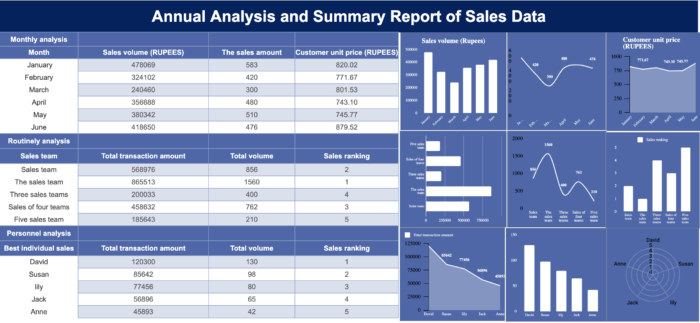
Visual representation of a business tracker with annual analysis and summary report.
Businesses use tools called business trackers to measure and keep an eye on various aspects of their operations. These tools help evaluate the performance of the business and identify areas that need improvement. They are used to monitor metrics related to sales, marketing, finance, and other areas of the business.
Business trackers can take various forms such as software programs, spreadsheets, or other tools that can be customized to fit a business’s specific needs. They are typically used to track metrics like revenue, expenses, profit margins, customer acquisition cost, and customer satisfaction.
Some common types of business trackers are:
-
Financial Trackers:
These tools help businesses track their finances and manage their cash flow. They can be used to monitor expenses, revenue, and profits, and provide insights into where the business stands financially.
-
Sales Trackers:
Sales trackers help businesses monitor their sales performance and identify trends in customer behavior. They can be used to track sales activity, customer interactions, and conversion rates, and provide insights into how to improve sales performance.
-
Project Trackers:
Project trackers help businesses manage their projects and track progress towards specific goals. They can be used to monitor project timelines, budgets, and resource allocation, and provide insights into how to optimize project performance.
-
Customer Trackers:
Customer trackers help businesses keep track of customer interactions and monitor customer satisfaction levels. They can be used to track customer feedback, support tickets, and other customer-related metrics, and provide insights into how to improve the customer experience.
-
Inventory Trackers:
Inventory trackers help businesses manage their inventory levels and track product availability. They can be used to monitor stock levels, track product sales, and optimize inventory management processes.
Overall, business trackers are important tools for businesses of all sizes and can help them make better decisions and improve their overall performance.
Why do Business Trackers exist?
- Helps you stay organized: They keep all your work stuff in one place.
- Tracks your goals: Like reminders for what you need to do and by when.
- Keeps your eye on the budget: They help you see where your money’s going.
- Planned teamwork: Everyone knows what they’re supposed to do.
- Makes difficult choices easier: Helps you decide what’s best for your business.
- Pushes you to grow: Shows what’s working and what’s not, so you can improve
Click here to download the free Sales Proposals & Quotations Template!
3. WhatsApp Sales Messages
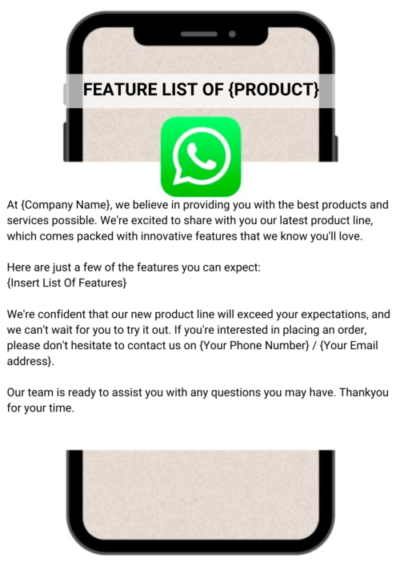
A WhatsApp sales message template for list of features of a particular product.
WhatsApp Sales Messages have become an all-time sales superhero due to their effectiveness. Businesses use these messages as a communication tool to connect directly with customers through WhatsApp. They help to provide personalized customer support, promote products and services, and drive sales.
Companies are drawn to WhatsApp Sales Messages because of their accessibility. With 2 billion+ active users globally, WhatsApp is one of the most popular messaging platforms worldwide. This enables businesses to reach a large and diverse audience without having to depend on more traditional marketing channels.
Here are some of the different types of WhatsApp messages:
-
Sales Messages:
Sales messages are used to promote products or services to potential customers. These messages should be persuasive, clear, and concise. They can include details about the product or service, benefits, and pricing. Examples of sales messages include:
-
Networking Messages:
Networking messages are used to initiate and maintain business relationships. These messages can be used to introduce yourself, share information about your business, and connect with potential customers or partners.
-
CEO Messages:
CEO messages are typically sent by the CEO or other high-level executives to employees, shareholders, or the public. These messages can be used to communicate important company news, updates, or changes in strategy.
-
Follow-up Messages:
Follow-up messages are used to maintain contact with customers or partners and to keep them engaged. These messages can be used to check in, provide updates, or share relevant information.
Click here to download the free WhatsApp Sales Messages Template!
4. Sales Follow-Up Emails
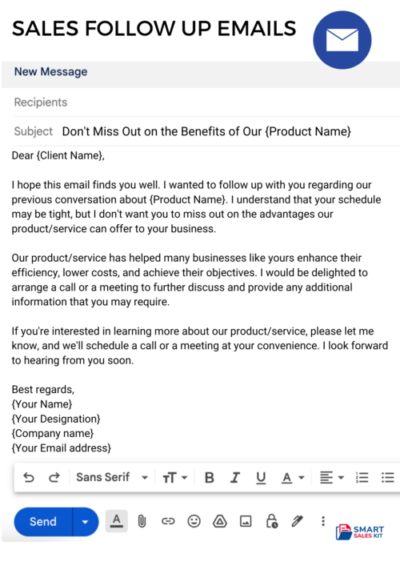
A sales follow up email template for a reminder to not miss out on product/service advantages.
Sales teams rely on follow-up emails as an integral part of their sales process. These emails help maintain contact with potential customers after the initial communication.
Hence by sending such emails, the sales team provides a reminder of the products or services being offered, as well as addressing any questions or concerns the customer may have.
But the content of these emails should not solely promote the product or service being offered. The goal is to build a rapport with the customer, moving the sales process forward in the process.
Tips you should know to write follow-up emails:
- Be timely and follow up within 1-2 days of your initial contact.
- Personalize your message by addressing the recipient by name and referencing specific information from your first interaction.
- Keep your message short and to the point to avoid losing the reader’s interest.
- Provide value by offering additional information or resources related to the recipient’s interests or needs.
- Include a clear call to action to guide the recipient on what to do next.
- Use a professional tone and avoid slang or errors in grammar and spelling.
- Follow up multiple times, spaced out over a reasonable period, to increase the likelihood of getting a response.
Click here to download the free Sales Follow-up Email Template!
5. SOP (Standard Operating Procedure)
SOP_s Sample documents (1)SOPs are crucial guidelines that explain in detail what employees need to know about carrying out a specific activity or process appropriately. They are explicit, step-by-step instructions that help your employees complete duties consistently and effectively. It is an essential tool for organizations. It can prove miraculous by lowering errors, improving productivity and profitability, fostering a safe workplace, and establishing policies to address issues and overcome challenges.
General Steps to Write an SOP:
Step 1: Identify the process or task:
The first step in writing an SOP is to identify the specific process or task that you want to document. This could be anything from a manufacturing process to a customer service protocol. It’s essential to be specific about the process or task so you can develop a comprehensive and effective SOP.
Step 2: Define the purpose and scope:
Once you have identified the process or task, the next step is- defining the purpose and scope of the SOP. This includes outlining the reason for the SOP’s creation, who it applies to, and what it covers. The purpose and scope of the SOP should be clearly defined so that all stakeholders understand its importance and relevance.
Step 3: Gather information:
This could include existing procedures, policies, regulations, and any other relevant information. You may need to consult with subject matter experts, employees, and managers to ensure that you have a comprehensive understanding of the process or task.
Step 4: Break down the process:
You should use specific and detailed language to describe each step, and organize the steps in a logical sequence. This will make it easier for readers to understand and follow the SOP.
Step 5: Organize the information:
Go ahead by using headings, subheadings, and bullet points to make the SOP easy to read and follow. Use a consistent format throughout the document, and consider incorporating visual aids such as diagrams, flowcharts, and illustrations to clarify complex instructions.
Step 6: Review and revise:
Once you have developed a draft of the SOP, review it for accuracy, completeness, and clarity. Always ensure that all steps are clearly defined and that the language used is easy to understand.
Revising the SOP is absolutely necessary to ensure that it is comprehensive, effective, and relevant to the process or task. It’s essential to make sure that all employees are aware of the SOP and are trained to follow it correctly.
Click here to download the free SOP Template!
6. KPI
Key Performance Indicators measure the success or progress of a business or organization towards its goals. They evaluate different areas like sales, marketing, operations, and finance, providing insights into the organization’s performance. KPIs should be specific, measurable, achievable, relevant, and time-bound. They should be clearly defined and quantifiable with a specific target or benchmark. Such indicators should also be realistic and achievable, taking into account the organization’s resources and capabilities.
Additionally, KPIs should be relevant to the goals of the organization and the area being measured. For instance, a marketing team’s KPI might be the number of leads generated, while an operations team’s KPI might be the percentage of orders shipped on time. These KPIs must be linked directly to the organization’s goals and provide insights into how well the goals are being achieved.
According to Statista, India’s e-commerce business is expected to grow to $120 billion in sales by 2025, which highlights how important KPIs are for online sales and digital marketing.
Click here to download the free KPI Template!
7. KRA
KRAs or Key Result/Responsibility Areas are crucial and specific areas of focus or responsibility to achieve business or organizational goals. They define the most significant areas of work or performance for an individual, team, or department and establish a framework to measure progress and success.
KRAs are useful at different levels within an organization, from individual performance plans to team and departmental goals. For instance, a sales team may have a KRA concerning the number of new accounts opened or the revenue generated from existing accounts. Similarly, a marketing team may have a KRA related to website traffic or lead generation.
Are KPI’s and KRA’s different?
In any performance management framework, KRAs and KPIs are two critical components. Although they are often used interchangeably, there are several important distinctions between them.
A person or team is held accountable for KRAs, which are broad areas of responsibility. These major areas of emphasis must be focused on to achieve organizational goals. KPIs, on the other hand, are particular measurable parameters that assess an individual’s or team’s performance in meeting their KRAs.
In simpler terms, KRAs are the “what” or areas that require attention, while KPIs are the “how” or measures used to evaluate progress in those areas.
Click here to download the free KRA Template!
8. Credit & Collection
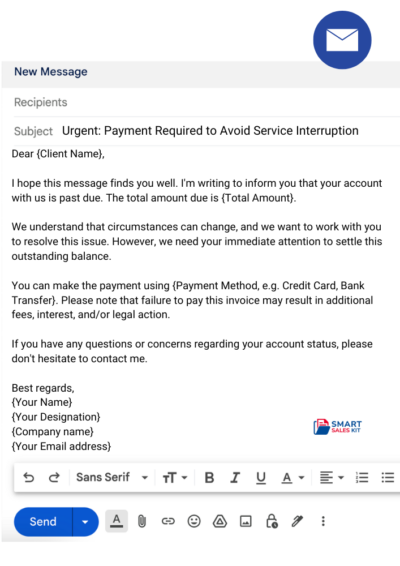
A business’s financial health relies heavily on effective credit and collection management. This process ensures a low risk of non-payment and improves cash flow, making it possible for the business to grow and expand. In addition, it helps to build and maintain positive relationships with clients by providing flexible payment options and ensuring smooth payment processing.
So to begin the credit and collection process, a customer first applies for credit and provides information about their creditworthiness. Upon approval, the customer is given a credit limit, which is the maximum amount they can borrow.
Once the customer starts using credit, the business monitors their purchases and sends regular invoices or statements. The customer is expected to pay the balance on these invoices within the agreed-upon payment terms. If a customer fails to make a payment on time, the collection process begins.
Effective credit and collection management is essential to minimize the risk of non-payment, improve cash flow, and maintain positive relationships with customers.
Key Takeaways of Creating a Credit and Collection Sales Document
Define payment terms: The payment terms and conditions, such as payment due date, late fees, and interest rates, should be clearly outlined in the agreement. This helps to set expectations early on and ensures that clients understand their financial duties.
Establish credit limits: The document should describe the customer’s maximum credit limit and any restrictions that may apply. This aids in credit risk management and ensures that consumers do not exceed their credit limit.
Create a credit application: Always include a credit application form that the customer must fill out in order to apply for credit. The application should collect all of the information needed to determine the customer’s “creditworthiness”, such as financial statements, credit references, and trade references.
Define collection policies: The document should outline the collection policy and procedures, such as when and how collections will be launched, what steps will be taken if payment is not received, and how disputes will be resolved.
Click here to download the free Credit & Collection Template!
9. Sales Emails
Businesses use sales emails to generate leads and reach potential customers. Sales emails aim to persuade prospects to take a specific action, such as buying a product or scheduling a sales call.
Thus to create effective sales emails, businesses need to understand their target audience’s needs and interests. They can achieve this by researching their demographics, interests, and pain points and tailoring their message to address these factors. The email’s tone should be friendly, professional, and persuasive, with a clear call to action that encourages the reader to take the next step.
Personalization is crucial, as emails that include the recipient’s name in the subject line have a 29% higher open rate and a 41% higher click-through rate. According to research, the best time to send a sales email is on Tuesday at 10 am, when open and click-through rates are typically the highest.
Hence, businesses can write effective sales emails using free sales email templates, which they can download and start using to get more responses.
Click here to download the free Sales Email Template!
10. Telemarketing Scripts
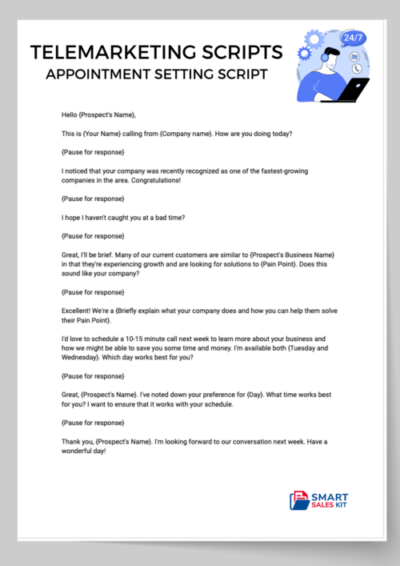
Telemarketers use pre-written outlines or talking points, known as telemarketing scripts, to guide their conversations with potential customers. These scripts help telemarketers stay on track, convey key selling points, be clear and concise, and handle common objections.
Crafting effective telemarketing scripts requires a deep understanding of the target audience, their needs, pain points, and the unique value proposition of the product or service being sold. Further while telemarketing scripts provide a consistent message, they can also be personalized to the needs and interests of the prospect. This helps build a stronger connection with the prospect and increases the chances of closing the sale.
Calls that begin with a compelling introduction have a 10% better likelihood of converting, according to Gong. Making a favorable impression during the initial 10-15 seconds of a telemarketing call is crucial. Therefore, salespeople can increase their chances of closing the sale and turning interested prospects into paying customers by having a structured follow-up plan in place.
Start closing more deals over the phone today with our free telemarketing script templates.
Click here to download the free Telemarketing Script Template!
11. Sales Plan
Sales _ Marketing Plans (1)A sales plan is a roadmap that outlines a company’s strategy for generating revenue and achieving its sales goals. In addition it is a critical component of any successful business, as it helps to define the target market, identify key performance indicators, and establish a plan for reaching sales targets. Therefore, a sales plan is absolutely important for any organization that wants to grow and succeed in a competitive market.
Sales Plan Tips
- Personalize your sales strategy to your ideal consumers’ demands and interests.
- Create quantifiable goals that align with your overall business objectives and establish a clear roadmap for your sales team.
- Calculate the amount of time, money, and resources required to reach your sales targets and allocate them accordingly.
- Provide continual training and development opportunities to your sales staff to improve their abilities and keep up with industry trends.
- Track and analyze sales data to identify areas for improvement and optimize your sales process.
- Ensure that your sales and marketing teams share common objectives, messaging, and strategies.
- Stay flexible and adaptable, and be willing to adjust your sales plan based on feedback, market changes, and other factors.
Click here to download the free Sales Plan Template!
12. Case Studies
In case studies, customers’ real-life experiences with a product or service are highlighted to show how it has solved a problem for them. This allows potential customers to see the benefits of the product or service and how it has helped other businesses or individuals achieve their goals.
Case studies are crucial sales documents because they prove a product or service’s effectiveness and build credibility. Besides they demonstrate that the company is not only committed to helping other businesses but also helping them grow. By increasing trust and confidence in potential customers, case studies can improve the likelihood of a successful sale.
Here’s an example of a case study:
- Select the appropriate brand: Suppose you choose Airbnb, a well-known vacation rental website that has upended the traditional hospitality business.
- Identify the issue: Airbnb faced the challenge of convincing potential customers to entrust their homes and personal goods to strangers.
- Explain the solution: The brand established a “Verified ID” program in which hosts and visitors were obliged to give government-issued identification, phone numbers, and email addresses. It helped in the development of user trust and the reduction of potential safety problems.
- Highlight the outcomes: Explain how the “Verified ID” program had helped Airbnb’s expansion, with the company now hosting over 7 million listings in over 220 countries. The program has also aided in the prevention of fraud and the protection of people from frauds.
- Include visual elements: Include photographs of the Airbnb website and app, screenshots of the “Verified ID” program, and user testimonials.
- Give your conclusion: Summarize the major insights from this program, such as the value of creating trust with consumers and leveraging technology to increase safety and security. The case study could also demonstrate how comparable trust-building activities can benefit other businesses.
13. Sales Decks
Sales decks are vital sales documents that present a product or service in a brief and persuasive manner to potential customers. They grab attention and spark interest, increasing the chances of generating leads and closing deals.
These documents may incorporate customer testimonials, case studies, or social proof to build credibility and trust with potential customers. Forbes conducted a study that found using storytelling in sales decks can increase retention by up to 65%.
14. Invoices
Invoices are like a polite reminder to customers that payment is due. It provides a clear breakdown of the work completed, the costs involved, and the payment terms. Invoices are important sales documents because they help to ensure that businesses get paid for their work. They also provide a professional and transparent way to request payment, and they can help to avoid misunderstandings or disputes over payment terms.
Furthermore this document also helps to build trust and credibility with customers by demonstrating that a business is organized and professional.
The key elements to include in a sales invoice:
- Invoice number – a unique identifier for the invoice.
- Invoice date – the date the invoice was issued.
- Payment terms – the agreed-upon terms for payment, such as “net 30”.
- Due date – the date by which payment is due.
- Description of goods/services – a clear and detailed description of what was sold.
- Quantity and unit price – the quantity of goods/services sold and their respective prices.
- Total amount due – the total amount the customer owes, including any applicable taxes or fees.
- Payment instructions – instructions for how the customer can pay, such as bank transfer or credit card.
- Company information – the name, address, and contact information of the company issuing the invoice.
- Customer information – the name and address of the customer who is being billed.
Click here to download the free Sales Invoice Template!
15. Playbooks
Sales playbooks provide a structured approach to sales and marketing by offering a step-by-step process for achieving specific goals. They include information on sales tactics, messaging, and strategies, as well as best practices and templates for various stages of the sales process. Hence, sales playbooks are important because they provide a consistent and repeatable approach to sales, leading to increased efficiency and success.
So here’s how you can create a sales playbook:
- Choose your target audience: Determine whether the playbook is intended for new sales representatives, experienced sales representatives, or managers.
- Establish your sales process: From lead generation to completing the purchase, define your sales process and break it down into manageable steps.
- Create buyer personas: This will reflect your ideal consumers and help you understand their requirements, difficulties, and ambitions.
- Develop sales messaging: Create clear and simple message that is consistent with your sales process and addresses your buyer profiles.
- Create sales tools: Create sales tools such as sales scripts, objection-handling instructions, and competitive battlecards to help your sales process.
- Create metrics and KPI’s: Track progress, such as the number of calls made, emails sent, and sales concluded.
- Implementation and training: Distribute the playbook and teach your sales team on its contents, ensuring that they know how to use it effectively.
- Regularly update the playbook: Regularly update the playbook to keep it relevant and in line with changes in your sales process, methodology, and market.
16. Pricing Sheets
Bids and Quotes - Pricing Strategy WorksheetPricing sheets provide a clear and succinct overview of a product’s or service’s costs and characteristics, similar to menus or catalogs. These ensure consistency in pricing by providing a standardized format for pricing information across different sales channels, such as online and offline sales.
Pricing Sheet Best Practices:
- Successful customers’ testimonials may assist future customers in gaining trust and credibility.
- To accommodate different clients’ needs and budgets, consider offering several pricing choices.
- Emphasize the main features and benefits of any product or service to help customers understand what they are paying for and why it is useful.
- All pricing sheets should follow the same format to make it easier for customers to compare different items or services.
- Inform customers of all expenses and fees associated with each product, including any taxes, shipping costs, or other fees that may apply.
Click here to download the free Pricing Sheets Template!
Step-By-Step Guide To Create Sales Documents
1) Know Why You Need Sales Documents
When you know the “why” behind your actions in business it automatically guarantees your chance of success. It is because this reasoning acts as guide to help you create a structured approach. You can have consistency and help out your customers in the best way. This way you can also get in proper link with your HR policies.
2) Gather All Possible Data-From Everywhere
Why? Think of it like this- when you know better, you do better! By collecting history, preferences, demographics and other things about customers, your product/service performance, market trends, and even keeping an eye on competitors, businesses gain valuable insights.
This collaboration enables the team to recognize new opportunities, develop strategies, improve customer experience, and stay one step ahead of the competition.
3) Take Time Out To Understand Customer Pain Points
Did you know? Companies that put the wants and needs of their customers first have a 60% better profit margin . Put yourself in their position; empathy is essential. You attract devoted clients that value your customer-centric strategy by resolving their pain issues..
That is why paying close attention, showing sincere empathy, and developing solutions will ease the customer’s troubles. By doing this, you build a loyal base of customers who enjoy your open and customer-centric style, which promotes business growth and success.
4) Paint a Visual Picture With Your Sales Documents
When you’re creating sales documents, don’t forget to add pictures and visuals. They actually will help keep your clients interested and engaged. Instead of just plain tables and text, images will make everything much simpler and easier to understand. Plus, they make the whole thing way more memorable. You know what they say, a picture is worth a thousand words! And it’s not just about information, pictures can also help link to emotions that go perfectly with what you’re selling.
One more great thing about using images is that they simplify complicated stuff. If you’ve got some tricky data or features, a simple chart or graph can make it better. And it gives you a professional look too. When people see you’ve put effort into making things look good, they take you more seriously.
So, keep in mind, visuals are the way to go when creating sales content.
5) Show Solid Proof Of Your Product
Your customers need to know for sure that you are the right choice for them-by showing how you were the best choice for others. With the help of case studies, references, testimonials, reviews and more you can basically prove your worth to your potential clients. Backing up your claims with these will make it easier for them to trust you. It will also signal them that you are ready to go ahead with serving them for a long time.
6) Make Sure Your Sales Document Content is Customized and Error-Free
People trust companies that pay attention to details. Also, when your material is targeted to the unique requirements of your audience, it becomes more personal and exciting. Clients want to know that they can believe what you’re saying. And when you explain your value effectively, customers realize why your product or service is fantastic for them. When you nail your sales paperwork, you can expect greater conversions.
Customers are more inclined to act action when they consider your sales documentation to be useful and trustworthy. It makes your brand stand out from the crowd. Being unique and providing clients with what they require sets you apart in a congested market. It improves your brand’s reputation, builds long-term connections with satisfied customers, and keeps the income going.
Also Read: Company Policy- List Of 45 Company Policies For Employees In India 2024
Sales Documents FAQ’s
1)What should be included in a sales document?
Sales documents should provide potential customers with essential information such as product features, benefits, pricing, and a call-to-action. Also they should be visually attractive and easy to read, with simple and clear language. Sales documents may also contain case studies, product demonstrations, or sales collaterals depending on the type of document.
2)What are the uses of sales documents?
Sales documents communicate information about a product or service to potential customers, showcasing features and benefits, providing pricing information, and closing deals. They build trust and credibility with potential customers by highlighting previous successes and demonstrating the value of the product or service.
3)What are the examples of sales documents?
Sales documents include sales decks, playbooks, case studies, pricing sheets, sales collaterals, product demonstration videos, proposals, invoices, and quotations. Each type of document serves a specific purpose in the sales process and can communicate different types of information to potential customers.
4)But how can I track the effectiveness of my sales documents?
Monitoring conversion rates is a way to track the effectiveness of sales documents. It involves tracking the number of potential customers who take the desired action after viewing the document. Therefore this enables sales teams to measure the effectiveness of their materials and make necessary adjustments.
5)What are some common mistakes to avoid when creating sales documents?
- To create effective sales documents, avoid technical language, too much information, and failure to highlight product benefits.
- Tailor the document for the customer and ensure it is visually appealing with clear formatting and easy-to-read fonts.
- Carefully proofread and edit the document to avoid errors or typos that could undermine its credibility.
Sales Documents Tips and Tricks
1)Convey a sense of urgency in your sales documents to encourage customers to act quickly. For example, offer a limited-time discount or emphasize high demand for your product.
2)Grab your customer’s attention and motivate them to take action by using strong, persuasive language in your sales document. Use words like “guaranteed,” “proven,” or “exclusive.”
3)Create an emotional connection with your customers. Show them how your product or service can help them achieve their goals by using storytelling techniques.
4)Influence your customer’s decision-making process. Make your sales document more persuasive by using psychological triggers like scarcity, social proof, and reciprocity.
5)Help your customers understand how your product or service works and how it can benefit them. Include a visual roadmap or flowchart in your sales document.
6)Optimize your approach by experimenting. Use different versions of your sales document with A/B testing to see which version performs better.
7)Make your pricing strategy more effective and persuasive by using pricing psychology techniques like anchoring, bundling, and tiered pricing.
8)Help your clients see how you have helped real people in real-world situations. Use storytelling techniques in your case studies instead of just presenting data and numbers.
Conclusion
So there you have it – sales documents go hand in hand when speaking of an easy flowing sales process. They help establish trust and credibility with customers, and they provide a clear roadmap for closing deals. Moreover, you can save time and ensure that you’re presenting the best possible image of your company to your customers.
Smart Sales Kit offers a comprehensive library of customizable sales documents and templates, with up to 3000+ sales documents that are are designed to meet the needs of sales teams in a wide range of industries. With our easy-to-use platform, you can customize these documents to reflect your brand, your products, and your unique selling proposition.
So, do you want to streamline your sales process and close more deals? Visit the Smart Sales Kit website today to learn more about our sales document templates and how they can help your sales team succeed. With our help, you can take your sales game to the next level and achieve the success you deserve.

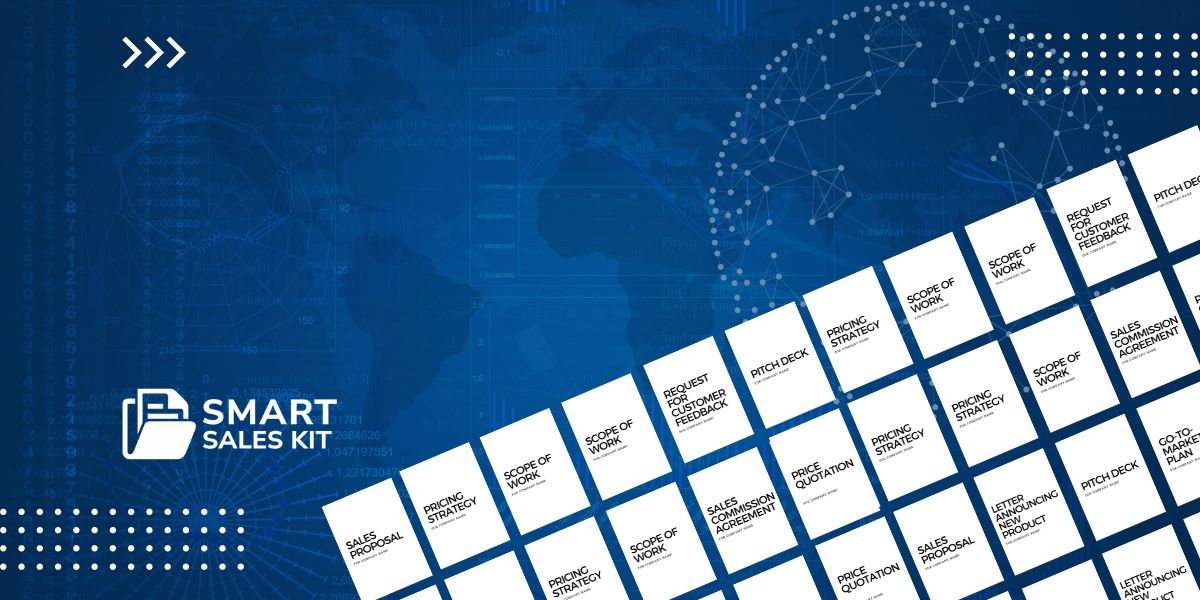




2 Comments